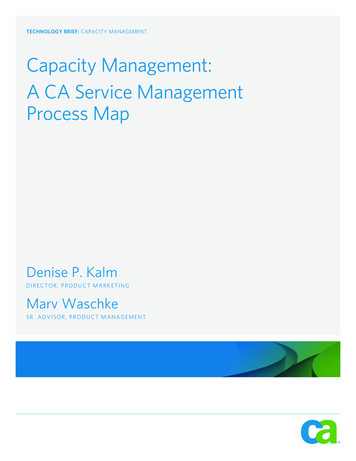
Transcription
SyncopeMANAGEMENT OF SYNCOPE IN THEACUTE CARE SETTINGMaureen C. Hughes, MDDartmouth Hitchcock NeurologyBC ‘99
DisclosuresNone of the planners or presenters of thissession have disclosed any conflict orcommercial interest
OBJECTIVES Describe the assessment of syncope. Identify appropriate testing and lab studies. Discuss the management in the acute caresetting. Patients will present to thehospital/Emergency Room with acutesyncope. This session will review theassessment and management of syncope inthe acute care setting.
The Patient John Doe (JD) is the 74 yo beloved patriarchwith a history of DM, HTN, CAD w stent, at hisgrandson’s 1 year old birthday party. He is helping his adorable grandson blow outhis candle when he passes out. There are 45 family members at the party, 15of them accompany him to the ED.
What is our plan? First elucidate the chief complaint to be surethe ‘spell’ is syncope using the patient historyand witness history. Syncope is a symptom, so determine type ofsyncope and cause of syncope. Then determine necessary evaluation strategyand treatment plan.
SyncopeSyncope is a symptom of hemodynamicdysfunction and not a disease.The symptom is: An abrupt but transient loss ofconsciousness associated with absence ofpostural tone followed by a rapid andcomplete recovery without the need forintervention. A prodrome may be present.The Triage RN flags JD as syncope in the EMR, takes his Vitalsigns and he gets an EKG and directs the patient and his now20 family members to a bed.
ICD 10Syncope and collapse -R55Applicable To :BlackoutFaintingVasovagal attack
ICD 10 Syncope : A transient loss of consciousnessand postural tone caused by diminished bloodflow to the brain. Presyncope : refers to the sensation oflightheadedness and loss of strength thatprecedes a syncopal event or accompanies anincomplete syncope. (from Adams et al.,Principles of Neurology, 6th ed, pp367-9)Extremely weak; threatened with syncope.
What we are thinking Syncope is a loss of consciousnessdue to a reduction in bloodpressure that is associated withan increase in vagal tone andperipheral vasodilation. What is the DDx for JD?
Framingham study data Of 727 patients with syncope, the cause was:vasovagal in 21%,orthostatic hypotension in 9.4%,cardiac causes in 9.5%,seizures in 4.9%,stroke or transient ischemic attack in 4.1%,medication related in 6.8%,other in 7.5%.Of importance, even with modern methods to assesscause, syncope was a result of an unknown cause in36.6% (31% of men and 41% of women)
Find the true SyncopePatients who complain of dizziness,light-headedness, passing out, and/orblacking out must be questionedcarefully to determine whether a truesyncope event has occurred.
Collapse, fainting, dizziness In one ED study of 121 patient that presentedafter a ‘collapse’, 19 were from cardiac arrest,4 were dead, 1 was asleep, 15 of the 121 werefinally diagnosed with syncope. -Olansky Syncope can mimic a seizure or metabolicderangement.
While they wait to see you,The patient’s daughter googles fainting “If you've ever fainted, you are not alone - at least one third of people faintsometime in their lives. Fainting is a temporary loss of consciousness. You losemuscle control at the same time, and may fall down. Most people recover quicklyand completely. Fainting usually happens when your blood pressure dropssuddenly, causing a decrease in blood flow to your brain. This is more common inolder people. Some causes of fainting include–––––– heat or dehydrationemotional distressstanding up too quicklycertain medicinesdrop in blood sugarheart problemsfainting is usually nothing to worry about, but it can sometimes be a sign of aserious problem. If you faint, it's important to see your health care provider andfind out why it happened.”She has decided and informed the other 22 family members that she thinks hehas had a TIA or it is his heart again.
Types of Syncope Vasovagal Carotid sinus syncope Situational syncope Cardiac-NINDS
Vasovagal The same as Neurocardiogenic syncope can be caused by, or provoked by, severalinciting, often noxious, stimuli. The specificstimulus can be difficult to characterize, canbe highly individualized, and can vary byphysical and emotional state. Emotional stresses alone (danger, real orperceived, fear, or anxiety) are commontriggers.
Carotid sinus syncope Carotid sinus syncope happensbecause of constriction of thecarotid artery in the neck and canoccur after turning the head,while shaving, or when wearing atight collar. NINDS
Situational syncope Situational syncope isspecifically triggered happens during urination,defecation, coughing, or as aresult of gastrointestinalstimulation. NINDS
Cardiac“Those who suffer from frequent and severe fainting often diesuddenly.”Hippocrates Aphorisms 2.41 1000 B.C.Cardiac syncope is a symptom of heartdisease or abnormalities that create anuneven heart rate or rhythm thattemporarily affect blood volume andits distribution in the body.-NINDS
What to rule out first Hemodynamic collapse from critical aorticstenosis, ventricular tachycardia, AV block,dissecting aortic aneurysm or pulmonaryembolus. In younger patients think prolonged QT,Hypertrophic cardiomyopathy, rightventricular dysplasia, Brugada syndrome,congenital Aortic stenosis
Syncope as a side effectCertain classes of drugs are associated with anincreased risk of syncope:diuretics,calcium antagonists,ACE narcotics, and alcohol.levodopa,Dopamine agonists which are used for PD and RLS.NINDS
A Neurologic symptomSyncope isn’t normally a primary sign ofneurological disorders but can be associatedwith: Parkinson’s disease, postural orthostatic tachycardia syndrome(POTS), diabetic and other types of neuropathy thatinvolve dysautonomia.NINDS
DiagnosisThe most important factor indiagnosing syncope is thecareful history for the typicalprodrome, signs andsymptoms.
The history for JDFor the first 10 minutes you hear about the party, whowas at the party, all about JDs last admission for his stent2 years ago and how they DID NOT like the SNF he wentto for recovery but they love his Cardiologist. Also, hemay be upset because someone who was supposed tocome didn’t show up for the party.Then his 19 yo granddaughter who is studying to becomean LNA pipes up and assures everyone that she saw thewhole thing and Grampa had a seizure.Every question you try to ask is followed by, how do youknow he didn’t have a TIA?
Taking the HistoryRegardless of the cause, patients with syncope present in asimilar fashion. At the start of an episode, an individual feels a sense ofuneasiness, progressing to unsteadiness, facial pallor, andperspiration; the vision can become darkenedconcentrically. During this time, nausea and vomiting can occur. Sighing can occur (an attempt to catch one's breath)because the person can have a feeling of shortness ofbreath. All these symptoms occur in the presyncope stage andusually last for less than 1 minute before loss ofconsciousness occurs.
Taking the history In cases of cardiac or carotid sinus syncope, theloss of consciousness can be rapid with littleprodrome. If the individual assumes a supine position duringthe presyncopal stage, syncope is often avoidedbecause cerebral perfusion is restored. However,an attempt to rise too quickly may lead toanother presyncopal episode.
Convulsive syncopeIf unconsciousness lasts for more than 15-20seconds, simple body and extremity jerks can beseen. This condition is termed convulsivesyncope.– It should not be confused with seizures.– Unlike those associated with a seizure, the jerkingmotions are single and erratic, nonrhythmic.
Odd presentations Prolonged syncope: Aortic stenosis, seizure, neurologic ormetabolic cause Slow recovery: Seizure, drug, ethanol intoxication, hypoglycemia,sepsis Injury: Arrhythmia, cardiac cause, neurocardiogenic Confusion Stroke, transient ischemic attack, intoxication,hypoglycemia Prolonged weakness: neurocardiogenic syncope Skin color: Pallor – neurocardiogenic;blue – cardiac;red – carbon monoxide Exercise-related: Ventricular or supraventricular tachycardia,hypotension/bradycardia. HOCM.
Your exam: Signs of syncope The degree of altered consciousness varies from astatic, dazed feeling to complete unconsciousness. During the syncopal period, the patient's systolic BPcan be expected to be less than 60-80 mm Hg, and thepatient's pulse may be thready. When he gets to theED- normal again. Sphincteral tone is typically maintained. Tongue biting of the type often noted with ageneralized convulsion does not occur. Once the patient is in the supine position, brainoxygenation is restored, and the patient regainsconsciousness. Otherwise myoclonus may occur. The patient can usually recall the presyncopalsymptoms that are critical to the diagnosis.
Injury Falling may cause injury if the individualcannot protect himself. This is of particularconcern in the elderly in whom the incidenceof falls is already high. Syncope leading to injury often reflects theability of the patient to react rather than theunderlying cause.
Your work up Vital signs and fingerstick BS EKG Lab workThen what? Do you need a HCT, an EEG? MRI? Echo? CUS?Tilt table test? EP study and a Pacer?Neurology and Cardiology consult?
Use of diagnostic testing Several tests should be considered: ECG, tilt table test,echocardiogram, electrophysiologic test, treadmill test, or amonitor. The more tests, the more abnormalities will be found. --------------------------- Some clinicians use a “routine” battery of tests that areuseless, expensive, and misleading. It is not clear how sometests and approaches (such as use of carotid Dopplertesting, EEG, MRI scans, CT scans, neurology consultations)emerged. All patients should have an ECG. An ECG is simple,inexpensive, risk free, and may provide helpful informationin 5–10% of patients. –Olshanksy 2005
Do we order an Echo for JD? An echocardiogram may be appropriate to evaluateventricular function and valvular heart disease but, if the ECG is normal, there is no cardiac history, andthere are no abnormalities found on physicalexamination, this does not need to be obtainedurgently. Younger patients, without a history of heart diseaseand with a normal physical examination, will beunlikely to benefit from an echocardiogram. Patientswith suspected neurocardiogenic syncope do not needan echocardiogram. - Olshansky 2005
The science behind the symptoms
Central artery of the retina The Ophth. Art is first branch off the internalcarotid. The central artery of the retina is the first branchto arise from the ophthalmic artery Once it reaches the eyeball, it splits into inferiorand superior branches When it reaches the retina those branch into atotal of 4 end branches of the central artery ofthe retina. BUT there is an anastamosis with the posteriorcilliary arteries called the Circle of Zinn
Why tunnel vision The circle of Zinn small vascular branchesanastomosing together in the sclera aroundthe head of the optic nerve.
Why sweating, pallor and nausea?Vagal tone isincreased in the skinand gut.
Lifestyle impact for JD Fear of recurrenceUp to 76% of patients will change ADLs64% will restrict their driving39% will change their employment73% become anxious or depressedespecially if the cause is not found andtreated.
Treatment-what to tell the family Immediate treatment :check first to see if their airway is open and theyare breathing. They should remain lying down forat least 10-15 minutes, preferably in a cool andquiet space. If this isn’t possible, have them sit forward andlower their head below their shoulders andbetween their knees. Ice or cold water in a cup is refreshing.From NINDS page
If you've ever fainted, you are notalone at least one third of people faintsometime in their lives. Fainting is a temporary loss ofconsciousness. You lose musclecontrol at the same time, andmay fall down. Most peoplerecover quickly and completely.
Forty to eighty-five percent of those whocome for evaluation of syncope will not have arecurrence. (not including those who don’tcome for evaluation.) Isolated episodes are common: 90% will haveonly one episode in 2 years.
Criteria for hospitalizationMalignant arrhythmia or cardiovascular causesuspectedNew neurologic abnormality presentSevere injury presentMultiple frequent episodesSevere orthostatic hypotensionUncontrolled “malignant” vasovagal syncopeElderly patientTreatment plans not possible as an outpatient-Olshansky 2005
Treating Chronic SyncopeFor individuals who have problems with chronicfainting spells, therapy should focus onrecognizing the triggers and learning techniquesto keep from fainting.At the appearance of warning signs such aslightheadedness, nausea, or cold and clammyskin, counter-pressure maneuvers that involvegripping fingers into a fist, tensing the arms, andcrossing the legs or squeezing the thighs togethercan be used to ward off a fainting spell.
What happened to JD? He stood up quickly and was mimicking taking adeep breath and blowing it out slowly for hisprecious grandson, when he had a coughing fit,he felt himself get light headed, sat back in achair and lost consciousness. His limbs shook,first right side, then all of them 2 or 3 times.Finally, he woke up after a few minutes to manymany stricken faces and a crying baby and askedwhat happened? What is your diagnosis?
References NINDS website: Syncope -R69/R55 Syncope: Mechanisms and ManagementSECOND EDITION Eds.Blair P. Grubb, MD BrianOlshansky, MD 2005.
John Doe (JD) is the 74 yo beloved patriarch with a history of DM, HTN, CAD w stent, at his grandson’s 1 year old birthday party. He is helping his adorable grandson blow out his candle when he passes out. There are 45 family











